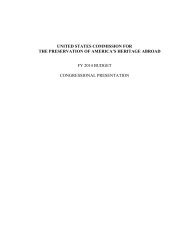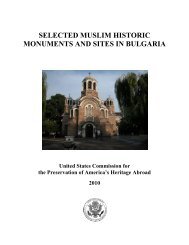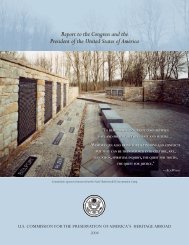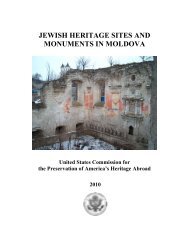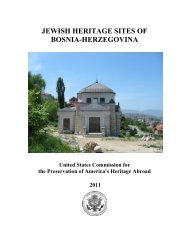jewish cemeteries, synagogues, and mass grave sites in ukraine
jewish cemeteries, synagogues, and mass grave sites in ukraine
jewish cemeteries, synagogues, and mass grave sites in ukraine
You also want an ePaper? Increase the reach of your titles
YUMPU automatically turns print PDFs into web optimized ePapers that Google loves.
Many of the most important Jewish th<strong>in</strong>kers of the modern age were born <strong>in</strong> those cities. In<br />
Kyiv <strong>and</strong> Odesa, for example, the Jewish Enlightenment movement; (known as the Haskalah,<br />
found some of its earliest support. These cities were also the home of such famous Yiddish <strong>and</strong><br />
Hebrew writers as Sholom Aliechem (1859-1916), I.L. Peretz (1852-1915), <strong>and</strong> Mendele<br />
Mocher Seforim (1835-1917) as well as important Zionist figures such as Leo P<strong>in</strong>sker (1821-<br />
1891), Ahad Ha-Am (1856-1927), <strong>and</strong> Vladimir Jabot<strong>in</strong>sky (1880-1940). The Haskalah<br />
movement also took hold <strong>in</strong> west central Ukra<strong>in</strong>e where, for example, Khotyn’s Jewish<br />
population grew after Bessarabia became part of Russia <strong>in</strong> 1812. By mid-century, it had become<br />
a center for Haskalah <strong>and</strong> even had a private school for girls.<br />
At the beg<strong>in</strong>n<strong>in</strong>g of the 19 th century, there was an organized, official attempt to settle Jews on the<br />
l<strong>and</strong> as farmers. Jewish agricultural colonies were created, <strong>and</strong> Jews were moved to the l<strong>and</strong>s of<br />
Kherson gubernia, beg<strong>in</strong>n<strong>in</strong>g a cont<strong>in</strong>uous movement of Jews east <strong>and</strong> south.<br />
By the beg<strong>in</strong>n<strong>in</strong>g of the 20 th century, Jews lived <strong>in</strong> almost all the towns of Ukra<strong>in</strong>e. They also<br />
constituted one-third of the total urban population. More than one-third of all Jews <strong>in</strong> western<br />
<strong>and</strong> central Ukra<strong>in</strong>e lived <strong>in</strong> towns or shtetls where they formed an absolute majority. The<br />
largest population lived <strong>in</strong> the western <strong>and</strong> southwestern areas.<br />
The brutal pogroms of 1881-82 were carried out mostly <strong>in</strong> Ukra<strong>in</strong>e; these atrocities <strong>and</strong><br />
economic hardship stimulated substantial Jewish emigration from the region to the United States<br />
<strong>and</strong> other countries. In 1903, there was a particularly brutal pogrom <strong>in</strong> Kish<strong>in</strong>ev (now Chis<strong>in</strong>au,<br />
the capital of Moldova.) More pogroms took place <strong>in</strong> 1905-06. The emigration to the United<br />
States began <strong>in</strong> the 1880s as a result of pogroms, but the most <strong>in</strong>tense emigration took place after<br />
1903. Jews also moved to Western Europe, Australia, <strong>and</strong> South America, but the greatest<br />
number immigrated to North America, particularly to the United States.<br />
The Russian Revolution <strong>and</strong> the Civil War of 1918-21 brought the greatest violence s<strong>in</strong>ce the<br />
17 th century aga<strong>in</strong>st Jews <strong>in</strong> Ukra<strong>in</strong>e <strong>and</strong> the greatest destruction of Jewish monuments. And<br />
although these horrors would be dwarfed by the terror of the Holocaust, <strong>and</strong>, thus, to some extent<br />
are forgotten, they ranked at the time among the worst catastrophes of Jewish history. Estimates<br />
put the Jewish death count at 35,000, with over 100,000 left homeless.<br />
II.2 First Independent Communist Periods (1917-1939) 15<br />
After 1917, Jews began to move <strong>in</strong> large numbers from small villages to big towns <strong>and</strong> cities, <strong>in</strong><br />
part because of the numerous pogroms <strong>in</strong> small towns dur<strong>in</strong>g the Civil War when Jews suffered<br />
from requisitions, robbery, <strong>and</strong> violence. From 1919 to 1921, violence aga<strong>in</strong>st Jews occurred <strong>in</strong><br />
more than 350 localities. A result was that the Jewish population of large cities such as Kyiv,<br />
Mykolaiv, Kharkiv, Donetsk, <strong>and</strong> Odesa <strong>in</strong>creased significantly.<br />
After a short period of Ukra<strong>in</strong>ian <strong>in</strong>dependence, the western third of present-day Ukra<strong>in</strong>e,<br />
<strong>in</strong>clud<strong>in</strong>g the city of Lviv, became part of the re-established Pol<strong>and</strong>, while the eastern part fell<br />
15 On this period see particularly Nora Lev<strong>in</strong>, The Jews <strong>in</strong> the Soviet Union S<strong>in</strong>ce 1917: Paradox of Survival, 2 vols.<br />
(New York <strong>and</strong> London: New York University Press, 1988).<br />
16




